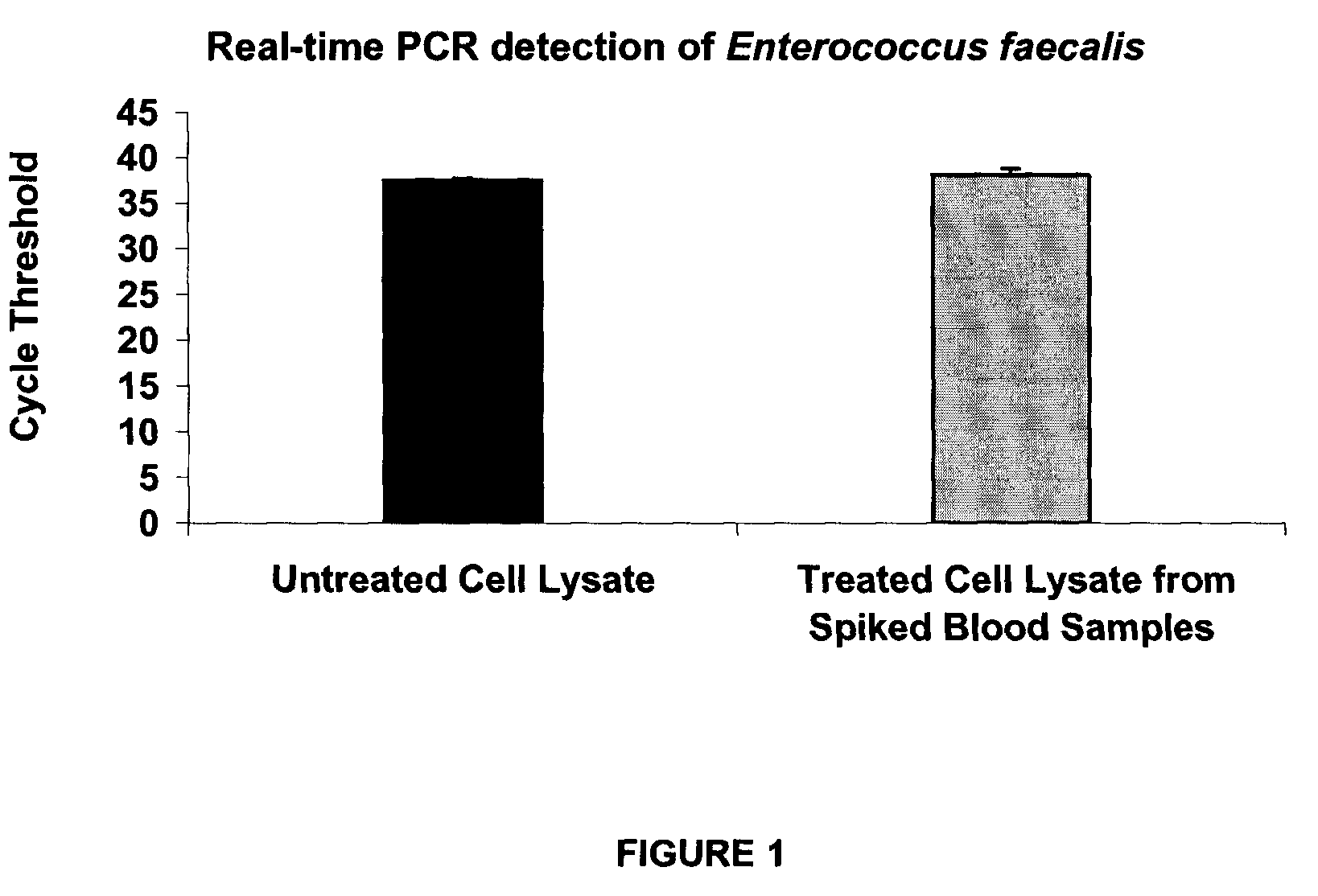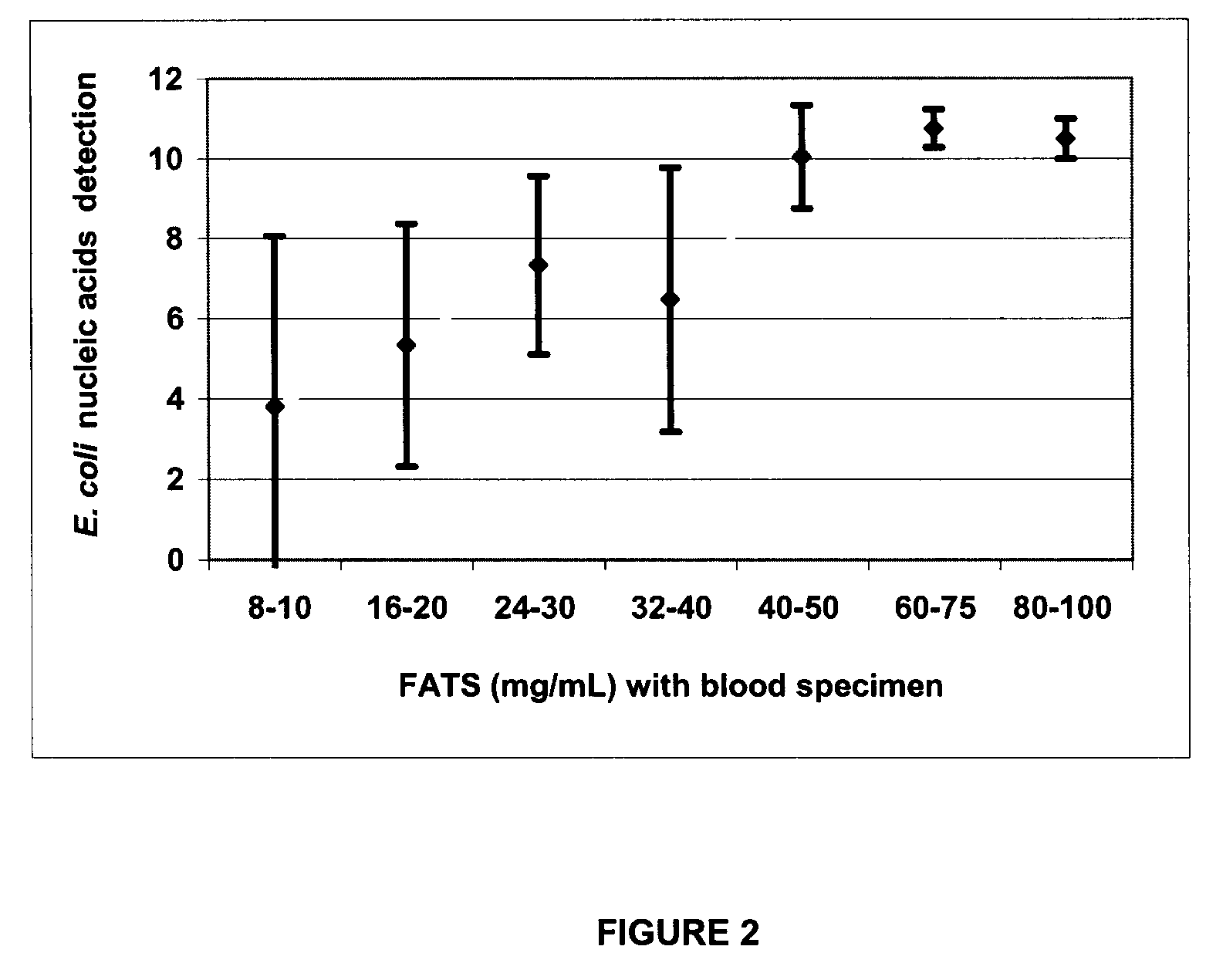Concentration and enrichment of microbial cells and microbial nucleic acids from bodily fluids
a technology of microbial cells and nucleic acids, which is applied in the direction of microorganisms, organic chemistry, microorganism lysis, etc., can solve the problems of morbidity and death, and the mortality rate of sepsis remains unacceptably high, ranging from 20% to 50%
- Summary
- Abstract
- Description
- Claims
- Application Information
AI Technical Summary
Benefits of technology
Problems solved by technology
Method used
Image
Examples
example 1
Experimental Procedures
[0063]The method(s) of the present invention comprises the steps of lysing blood cells (for example, more than 90% of blood cells) while protecting microbial cells and their nucleic acids using a solution which may comprise treated saponin at a final concentration ranging from about 20 to about 100 mg / mL; washing blood cell lysate to remove a significant fraction of nucleic acids from blood cells as well as controlling inhibitors from blood components while preserving microbial cells and their nucleic acids; harvesting concentrated microbial cells and their nucleic acids and / or extracting microbial nucleic acids. For such purpose, the following conditions and / or reagents are used.
[0064]Saponin reagent was prepared by resuspending saponins in the form of powdered extract from Quillaja saponaria Molina bark into a suitable hypotonic or a physiological solution. Saponin extracts from Quillaja saponaria bark, cleared out from low molecul...
example 2
Efficient Isolation and Detection of Microbial Cells and Their Nucleic Acids from Blood Samples
[0084]5 mL of whole blood samples were inoculated with an average of 10 CFU / mL of Enterococcus faecalis. The spiked blood was treated with saponin using the two-step method described in Example 1. During the first step, 15 mL of 100 mg / mL HFATS in TE 1× was added to the spiked blood sample and mixed for 10 seconds using a vortex set at maximum speed. Pelleted blood residues and microbial cells were obtained by centrifugation at 10 000 g for 5 minutes, and the supernatant was discarded. In a second step, 10 mL of 100 mg / mL HFATS in TE 1× was added to the harvested pellet and mixed 10 seconds using a vortex set at maximum speed, then centrifuged at 10 000 g for 5 minutes and the supernatant was discarded.
[0085]The pellet was washed in 1.7 mL of PBS 1× by up and down pipetting. The suspension was centrifuged at 10 000 g for 1 minute and the supernatant was discarded. The washing step was repe...
example 3
Effect of Increasing Concentrations of Saponin on E. Coli Nucleic Acids Detection
[0088]The effect of increasing concentrations of filtered, autoclaved treated saponin (FATS) solution on the detection of E. coli nucleic acids was monitored. The microorganism DNA was recovered from blood specimens spiked with live microbial cells. 10 mL of whole blood sample were inoculated with an average of 400 CFU of E. coli per mL. Initial CFU / ml counts were determined by culturing serial dilutions in PBS 1× on solid media. This assay was completed using the two-step treatment with FATS as described in Example 1. During the first step, 40 mL of FATS in TE 1× were added to the spiked blood sample and mixed for 10 seconds using a vortex set at maximum speed. A pellet was obtained by centrifugation at 10 000 g for 5 minutes, and the supernatant was discarded. In a second step, 45 mL of FATS in TE 1× was added to the pellet and mixed for 10 seconds using the vortex set at maximum speed. Subsequently, ...
PUM
| Property | Measurement | Unit |
|---|---|---|
| concentration | aaaaa | aaaaa |
| concentration | aaaaa | aaaaa |
| pore size | aaaaa | aaaaa |
Abstract
Description
Claims
Application Information
 Login to View More
Login to View More - R&D
- Intellectual Property
- Life Sciences
- Materials
- Tech Scout
- Unparalleled Data Quality
- Higher Quality Content
- 60% Fewer Hallucinations
Browse by: Latest US Patents, China's latest patents, Technical Efficacy Thesaurus, Application Domain, Technology Topic, Popular Technical Reports.
© 2025 PatSnap. All rights reserved.Legal|Privacy policy|Modern Slavery Act Transparency Statement|Sitemap|About US| Contact US: help@patsnap.com


